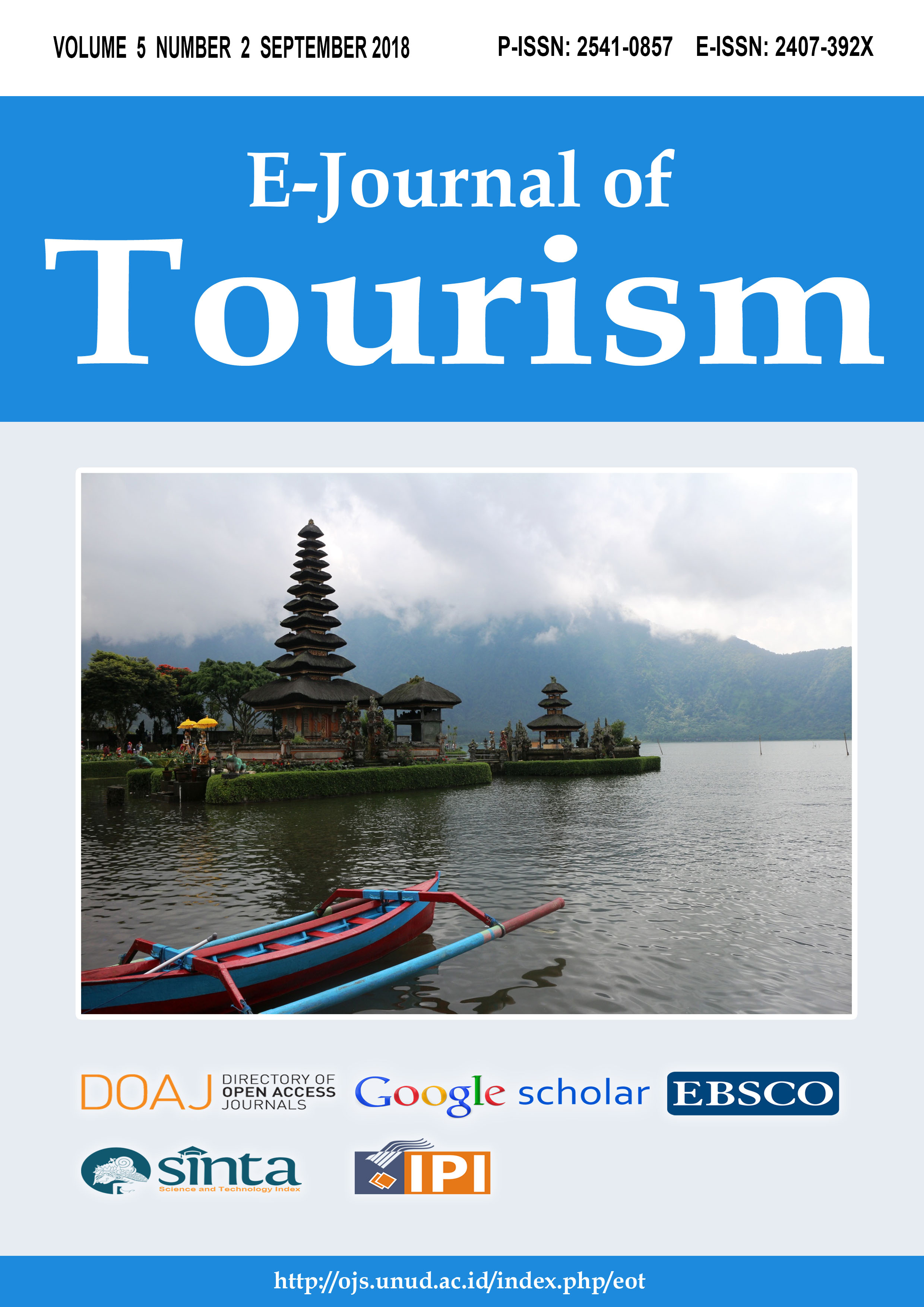Family Tourist - is Different Motive, Different Choice of Tourist Activity?
Abstract
Currently, many families travelling to various tourist destinations. This phenomenon is interesting to be investigated. Existing research results can be utilized by stakeholders to develop their own policies and strategies. However, at this time not much study exists in family travel. This study examines family’s travel motivations, family’s activities in destination, and the differences of family’s activity choice across categories of travel motivations. Survey method has been employed in this study. The sample was obtained from a residence in Bogor City, West Java and consisted of 300 families chosen by convenience sampling technique. Data were analyzed using descriptive analysis and hypothesis test using chi-square. The findings indicated that there were two dominant family’s travel motivations, personal escape and interpersonal seeking. The family chose natural, cultural, and special tourist activities. Family’s activity choice across categories of travel motivations was the same except rafting. It was most preferred by families who had personal escape motivation.
Downloads
References
Berlianti, D. et al. (2017) ‘Ada apa dengan komunikasi orang tua-remaja?: pengaruhnya terhadap agresivitas remaja pada sesama’, Jurnal Ilmu Keluarga & Konsumen, 9(3), pp. 183–194.
Birenboim, A. et al. (2013) ‘Temporal activity patterns of theme park visitors’, Tourism Geographies. Taylor & Francis, 15(4), pp. 601–619.
Bowen, D. and Clarke, J. (2009) Contemporary Tourist Beh... Cabi.
Chen, M. and Pang, X. (2012) ‘Leisure motivation: An integrative review’, Social Behavior and Personality: an international journal. Scientific Journal Publishers, 40(7), pp. 1075–1081.
Damanik, J. (2013) Pariwisata Indonesia: antara peluang dan tantangan. Pustaka Pelajar.
Damanik, J. (2014) ‘Meanings, Purposes, and Activities of Suburban Family Tourism in Yogyakarta, Indonesia’, dalam Rethinking Asian Tourism: Culture, Encounters and Local Response, Diedit oleh P. Porananond dan VT King, UK: Cambridge Scholars Publishing, pp. 266–283.
Goeltom, A. D. and Mulyawan, R. (2007) ‘Menentukan preferensi dan faktor-faktor yang menyebabkan wisatawan berkunjung ke Kota Bandung sebagai daerah tujuan wisata’, Jurnal Pariwisata, 8(4), pp. 44–58.
Hazel, N. (2005) ‘Holidays for children and families in need: An exploration of the research and policy context for social tourism in the UK’, Children & Society. Wiley Online Library, 19(3), pp. 225–236.
Hsu, C. H. C., Cai, L. A. and Li, M. (2010) ‘Expectation, motivation, and attitude: A tourist behavioral model’, Journal of travel research. Sage Publications Sage CA: Los Angeles, CA, 49(3), pp. 282–296.
Ingkadijaya, R. et al. (2016a) ‘Aktivitas Wisata Pilihan Keluarga Perkotaan’, Khasanah Ilmu-Jurnal Pariwisata Dan Perhotelan, 7(1).
Ingkadijaya, R. et al. (2016b) ‘Tourist activities contribution on family cohesion’, Heritage, Culture and Society: Research agenda and best practices in the hospitality and tourism industry. CRC Press, pp. 345–350.
Inskeep, E. (1991) Tourism planning: an integrated and sustainable development approach. Van Nostrand Reinhold.
De Leeuw, E. D., Hox, J. and Dillman, D. (2012) International handbook of survey methodology. Routledge.
Lestari, S. (2012) Psikologi keluarga: Penanaman nilai dan penanganan konflik dalam keluarga. Sri Lestari.
Manulang, S., Bendesa, I. K. G. and Putra, I. N. D. (2015) ‘The Effect of Service Quality in International Airport I Gusti Ngurah Rai on Satisfaction, Image, and Tourists Loyalty Who Visited Bali’, E-Journal of Tourism, 2(1), pp. 9–21.
Nickerson, N. P. and Jurowski, C. (2001) ‘The influence of children on vacation travel patterns’, Journal of Vacation Marketing. Sage Publications Sage CA: Thousand Oaks, CA, 7(1), pp. 19–30.
Oktaria, R., Krisnatuti, D. and Muflikhati, I. (2015) ‘SUMBER STRES, STRATEGI KOPING, DAN TINGKAT STRES PADA BURUH PEREMPUAN BERSTATUS MENIKAH DAN LAJANG’, Jurnal Ilmu Keluarga & Konsumen, 8(3), pp. 133–141.
Recours, R. A., Souville, M. and Griffet, J. (2004) ‘Expressed motives for informal and club/association-based sports participation’, Journal of Leisure Research. Taylor & Francis, 36(1), pp. 1–22.
Shi, L., Cole, S. and Chancellor, H. C. (2012) ‘Understanding leisure travel motivations of travelers with acquired mobility impairments’, Tourism Management. Elsevier, 33(1), pp. 228–231.
Shoval, N. et al. (2011) ‘Hotel location and tourist activity in cities’, Annals of Tourism Research. Elsevier, 38(4), pp. 1594–1612.
Simanjuntak, M. and Sabrina, O. (2015) ‘APAKAH KEPRIBADIAN, KEKOSMOPOLITAN, DAN ORIENTASI NILAI MENENTUKAN KUALITAS HIDUP SUBJEKTIF KELUARGA?’, Jurnal Ilmu Keluarga & Konsumen, 8(3), pp. 173–181.
Suardana, I. W., Bendesa, I. K. G. and Antara, M. (2014) ‘Satisfaction as Mediators of the Relationship between Motivation and Loyalty of Diving Tourists to Bali’, E-Journal of Tourism, 1(1), pp. 12–24.
Sudiarta, I. N. (2015) ‘Popularity of tourist attraction in Bali from the perspective of foreign tourists’, E-Journal of Tourism, 2(2), pp. 68–73.
Tangeland, T. and Aas, Ø. (2011) ‘Household composition and the importance of experience attributes of nature based tourism activity products–A Norwegian case study of outdoor recreationists’, Tourism Management. Elsevier, 32(4), pp. 822–832.
Utama, I. G. B. R., Putra, N. D. and Suradnya, I. M. (2014) ‘Destination Loyalty Model of Elderly Foreign Tourists Visiting Bali’, E-Journal of Tourism, 1(1), pp. 50–56.
Walker, G. J., Deng, J. and Dieser, R. B. (2005) ‘Culture, self-construal, and leisure theory and practice’, Journal of Leisure Research. Taylor & Francis, 37(1), pp. 77–99.

This work is licensed under a Creative Commons Attribution 4.0 International License.
The copyright of the received article shall be assigned to the journal as the publisher of the journal. The intended copyright includes the right to publish the article in various forms (including reprints). The journal maintains the publishing rights to the published articles.




















